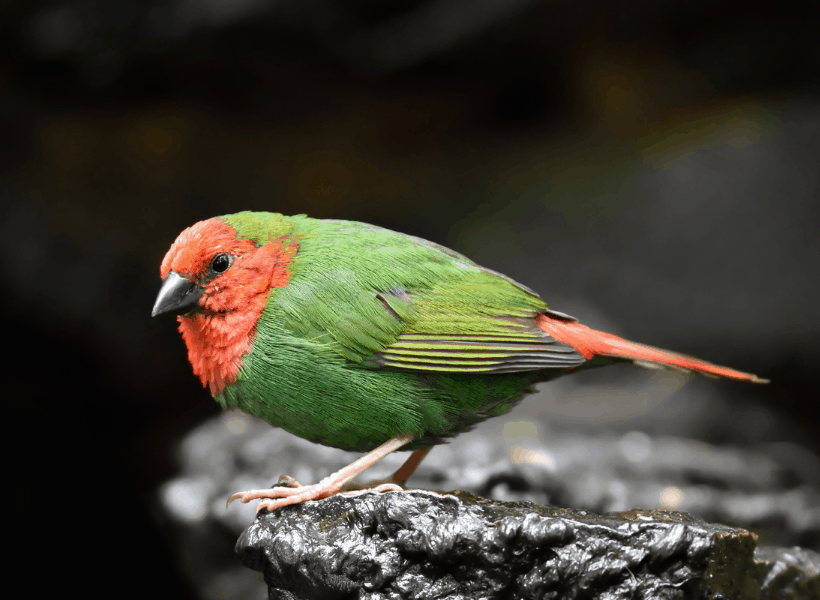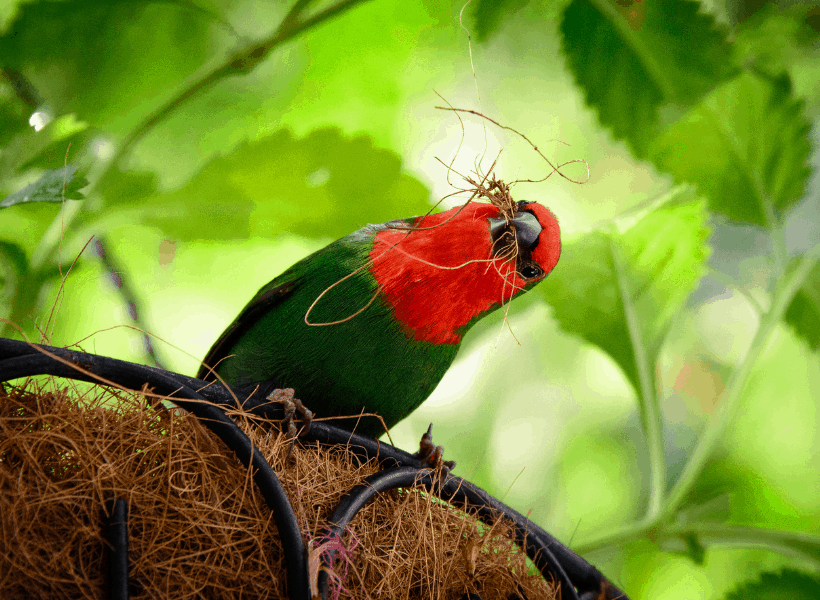The red throated parrotfinch is a member of a family of Estrildidae finches that is well known in captivity and contains one species that is often not recognised as a parrotfinch – the Gouldian finch. Parrotfinches in general are colourful birds, mainly green with red, blue and other shades.
The red throated earns its name with a bright green body and red head. Confusingly, it is usually known as the red-headed parrotfinch in captivity, although there is another species with this name that isn’t seen in aviaries. It is also a great species to start with and will live peacefully with other species.
In the wild
In the wild, the red throated parrotfinch Erythrura psittacea is a native of one location, an island called New Caledonia some 800 miles from the coast of Queensland, Australia.
It is known as the red faced parrotfinch as well as red headed and red throated. Which is a bit confusing as within the family are also the red-eared parrotfinch (Erythrura coloria) also known as the Mount Katanglad parrotfinch and the red headed parrotfinch (Erythrura cyaneovirens). Simple, right?
Their natural habitat are open grassy areas with some shrubs including gardens, forest edges and clearings, even plantations. Outside breeding season, they live in groups and can be seen feeding on the ground as well as in vegetation. They then separate up for breeding season when pairs go to nest in crevices in buildings or in trees.
Description
As the name suggests, these birds have a bright red head and throat as well as rump and tail. The rest of the bird is a bright green shade with a black beak and horn-coloured leg. Juveniles are lighter in colour and the beak has an amber colour when young. They are around 12cm in length or 4 ¾ inches.

It is very hard to sex the birds visually though some cock birds may be brighter in colour than hens. Only the cock has a full song, a repeating whistling song that is quite loud.
There are a number of nice mutations in this species:
- Seagreen – green turns to a turquoise green shade and the red becomes orange
- Blue – green becomes blue and the red becomes a salmon colour
- Pied – random splashes of yellow on the green areas, white on seagreen birds
These birds can hybridise with other members of the parrotfinch family, including Gouldians. There are also notes about various Estrildidae crosses but these seem much less common. In my experience, keep these birds away from the Blue faced parrotfinches, a more aggressive species who will almost force themselves on the quieter birds and breed hybrids.
Keeping the red throated parrotfinch
A good foreign finch mix is a great starting point for these birds though there is special parrotfinch mixes available from some suppliers. They will also enjoy grass seeds, niger and poppy seeds and millet spray. Greens such as kale and broccoli is often enjoyed along with fruits such as apples, oranges and berries. They will usually eat egg food and grit, cuttlebone or a mixture should be available.
Some breeders recommend keeping this birds in flights while others have had success in good sized cages – often where the bird was raised will impact where is best to keep them. They can be prone to picking up parasites in their intestines as they feed from the floor so regular worming may be worth considering. They can become obese in cages if too rich a diet is fed to them such as too much niger or other fatty seeds.
Keeping them in a flight, they will enjoy vertical perches or plants that allow them to grab and hang as well as normal horizontal perches. Natural or fake plants will also great a natural environment that can make the birds more comfortable.
Breeding
The red throated parrotfinch is rated as a good species to breed, mostly rearing their own young and being good parents. It is advisable to wait until they are at least 9 months old before breeding them and can be bred one pair to an enclosure or in colonies, as long as there is the same number of cocks as hens (or more hens).
The birds will choose from a variety of nesting sites including nest boxes, hollowed logs and in trees or shrubs. You can add some nesting material to show them the location and then they will add their own, including lining it with feathers and grass. Both birds do incubation duties.

During breeding, their diet should include live food, though this might not be needed depending on what they are used to. They should also have egg food, sprouted seed, half ripe seeds and vegetables such as peas and corn. Between three and six eggs are laid and incubated for 12-14 days.
Chicks have those iridescent nodules at the corners of their beak that act like a signpost for parents to deposit food. They fledge from the nest at around 21 days old and don’t normally return to the nest to roost after this. They will be weaned at around three weeks after this and can then be removed from the parents if required.
Birds can have three clutches a year and will nest at any time of the year, depending on the conditions.
5
Very nice description.